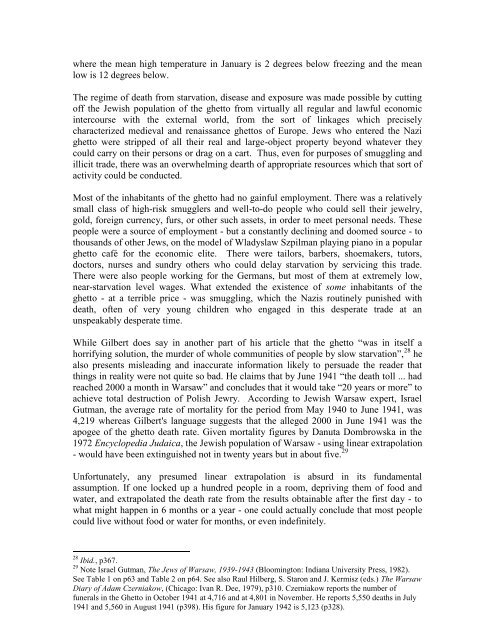ja chank 2008 - South African Jewish Board of Deputies
ja chank 2008 - South African Jewish Board of Deputies
ja chank 2008 - South African Jewish Board of Deputies
Create successful ePaper yourself
Turn your PDF publications into a flip-book with our unique Google optimized e-Paper software.
where the mean high temperature in January is 2 degrees below freezing and the mean<br />
low is 12 degrees below.<br />
The regime <strong>of</strong> death from starvation, disease and exposure was made possible by cutting<br />
<strong>of</strong>f the <strong>Jewish</strong> population <strong>of</strong> the ghetto from virtually all regular and lawful economic<br />
intercourse with the external world, from the sort <strong>of</strong> linkages which precisely<br />
characterized medieval and renaissance ghettos <strong>of</strong> Europe. Jews who entered the Nazi<br />
ghetto were stripped <strong>of</strong> all their real and large-object property beyond whatever they<br />
could carry on their persons or drag on a cart. Thus, even for purposes <strong>of</strong> smuggling and<br />
illicit trade, there was an overwhelming dearth <strong>of</strong> appropriate resources which that sort <strong>of</strong><br />
activity could be conducted.<br />
Most <strong>of</strong> the inhabitants <strong>of</strong> the ghetto had no gainful employment. There was a relatively<br />
small class <strong>of</strong> high-risk smugglers and well-to-do people who could sell their jewelry,<br />
gold, foreign currency, furs, or other such assets, in order to meet personal needs. These<br />
people were a source <strong>of</strong> employment - but a constantly declining and doomed source - to<br />
thousands <strong>of</strong> other Jews, on the model <strong>of</strong> Wladyslaw Szpilman playing piano in a popular<br />
ghetto café for the economic elite. There were tailors, barbers, shoemakers, tutors,<br />
doctors, nurses and sundry others who could delay starvation by servicing this trade.<br />
There were also people working for the Germans, but most <strong>of</strong> them at extremely low,<br />
near-starvation level wages. What extended the existence <strong>of</strong> some inhabitants <strong>of</strong> the<br />
ghetto - at a terrible price - was smuggling, which the Nazis routinely punished with<br />
death, <strong>of</strong>ten <strong>of</strong> very young children who engaged in this desperate trade at an<br />
unspeakably desperate time.<br />
While Gilbert does say in another part <strong>of</strong> his article that the ghetto “was in itself a<br />
horrifying solution, the murder <strong>of</strong> whole communities <strong>of</strong> people by slow starvation”, 28 he<br />
also presents misleading and inaccurate information likely to persuade the reader that<br />
things in reality were not quite so bad. He claims that by June 1941 “the death toll ... had<br />
reached 2000 a month in Warsaw” and concludes that it would take “20 years or more” to<br />
achieve total destruction <strong>of</strong> Polish Jewry. According to <strong>Jewish</strong> Warsaw expert, Israel<br />
Gutman, the average rate <strong>of</strong> mortality for the period from May 1940 to June 1941, was<br />
4,219 whereas Gilbert's language suggests that the alleged 2000 in June 1941 was the<br />
apogee <strong>of</strong> the ghetto death rate. Given mortality figures by Danuta Dombrowska in the<br />
1972 Encyclopedia Judaica, the <strong>Jewish</strong> population <strong>of</strong> Warsaw - using linear extrapolation<br />
- would have been extinguished not in twenty years but in about five. 29<br />
Unfortunately, any presumed linear extrapolation is absurd in its fundamental<br />
assumption. If one locked up a hundred people in a room, depriving them <strong>of</strong> food and<br />
water, and extrapolated the death rate from the results obtainable after the first day - to<br />
what might happen in 6 months or a year - one could actually conclude that most people<br />
could live without food or water for months, or even indefinitely.<br />
28 Ibid., p367.<br />
29 Note Israel Gutman, The Jews <strong>of</strong> Warsaw, 1939-1943 (Bloomington: Indiana University Press, 1982).<br />
See Table 1 on p63 and Table 2 on p64. See also Raul Hilberg, S. Staron and J. Kermisz (eds.) The Warsaw<br />
Diary <strong>of</strong> Adam Czerniakow, (Chicago: Ivan R. Dee, 1979), p310. Czerniakow reports the number <strong>of</strong><br />
funerals in the Ghetto in October 1941 at 4,716 and at 4,801 in November. He reports 5,550 deaths in July<br />
1941 and 5,560 in August 1941 (p398). His figure for January 1942 is 5,123 (p328).











